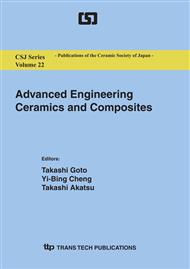[1]
Neville A. M., Properties of Concrete, Fourth Edition, London England: Pitman Books Limited, (1995).
Google Scholar
[2]
Leung, K.Y.C. and Pheeraphan, T., Microwave Curing of Portland Cement Concrete: Experimental Results and Feasibility for Practical Applications, Construction and Building Materials, Vol. 9, No. 2, p.67 – 73, (1995).
DOI: 10.1016/0950-0618(94)00001-i
Google Scholar
[3]
Verbeck, G.J., Helmuth, R.A., Structures and Physical Properties of Cement Paste, 5th Int. Congress Cement Chemistry, Tokyo, Japan, p.1 – 44, (1969).
Google Scholar
[4]
Leung, K.Y. C, Pheeraphan, T., Determination of Optimal Process for Microwave Curing of Concrete. Cement and Concrete Research, 27: p.463 – 472, (1997).
DOI: 10.1016/s0008-8846(97)00015-x
Google Scholar
[5]
Dongxu, L., Xuequan, W. A Study on the Application of Vacuum Microwave Composite Dewatering Technique in Concrete Engineering, Cement and Concrete Research, 24: p.159 – 164, (1994).
DOI: 10.1016/0008-8846(94)90097-3
Google Scholar
[6]
Hutchison, R.G., Chang, J.T., Jennings, H.M., Brodwin, M.E., Thermal Acceleration of Portland Cement Mortars with Microwave Energy. Cement and Concrete Research, 21: p.795 – 799, (1991).
DOI: 10.1016/0008-8846(91)90174-g
Google Scholar
[7]
American Society for Testing and Materials, Annual Book of ASTM Standard Vol. 4. 01, Philadelphia, PA, USA, (2009).
Google Scholar
[8]
American Society for Testing and Materials, Annual Book of ASTM Standard Vol. 4. 02, Philadelphia, PA, USA, (2009).
Google Scholar
[9]
Cario, N., The Maturity Method: Theory and Application. Reprinted from the Proceedings of the 2001 Structures Congress & Exposition, May 21-23, Washington, D.C., American Society of Civil Engineers, Reston, Virginia, Peter C. Chang, Editor, (2001).
Google Scholar
[10]
Benameur, H.K., Wirquin, E., Duthoit, B., Determination of Apparent Activation Energy of Concrete by Isothermal Calorimetry. Cement and Concrete Research, 30(2): p.301 – 305, (2000).
DOI: 10.1016/s0008-8846(99)00250-1
Google Scholar
[11]
Tank, R. C. and Carino, N. J. Rate constant functions for strength development of concrete. ACI Materials Journal 88, No. 1, 74 – 83, (1990).
Google Scholar
[12]
Chanvillard, G. and D'Aloia, L. Concrete strength estimation at early ages: modification of the method of equivalent age. ACI Materials Journal 94, No. 6, 520 –530, (1997).
DOI: 10.14359/336
Google Scholar
[13]
Abdel-Jawad, Y. A. and Hansen, W. The effect of temperature on hydration kinetics of Portland cement. In Proceedings of the 1st International Conference on Reinforced Concrete Materials in Hot Climates, Al Ain, UAE. UAE University Press, United Arab Emirates, vol. 1, p.121 – 133, (1994).
Google Scholar
[14]
Yahia A. Abdel-Jawad. Estimating concrete strength using a modified maturity model, Proceedings of the Institution of Civil Engineers Construction Materials 159, February Issue CM1 Pages 33 – 37, (2001).
DOI: 10.1680/coma.2006.159.1.33
Google Scholar
[15]
Moukwa, M. et al., The influence of the hydration process upon microwave properties of cements", Cement and Concrete Research Vol. 21 (1991), p.863 – 872, (1991).
DOI: 10.1016/0008-8846(91)90181-g
Google Scholar
[16]
Hewlett, P. C., Lea's chemistry of cement and cementitious material. Fourth Edition, New York: John Wiley & Sons Inc., (1998).
Google Scholar
[17]
Flint, E.P., Well, L.S., Study of the System CaO2–H2O at 30 0C and the Reaction of Water on the Anhydrous Calcium Silicates, Journal of Research Natural Bulletin Standards, 12: p.751 – 756, (1934).
DOI: 10.6028/jres.012.060
Google Scholar
[18]
Feng, L., Meyer, C., Hydration Kinetics Modeling of Portland Cement Considering the Effects of Curing Temperature and Applied Pressure. Cement and Concrete Research, 39: p.255 – 265, (2009).
DOI: 10.1016/j.cemconres.2009.01.014
Google Scholar


